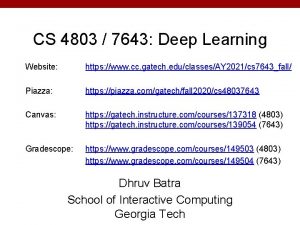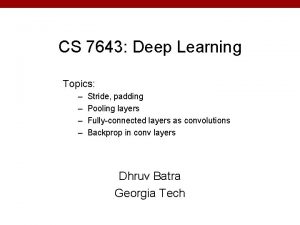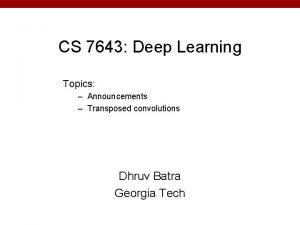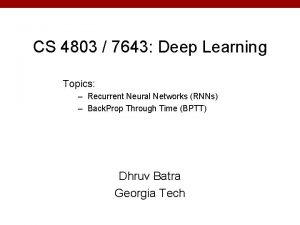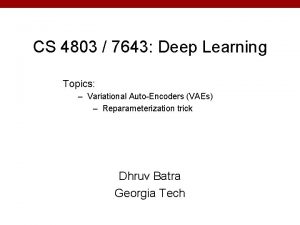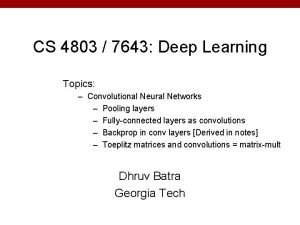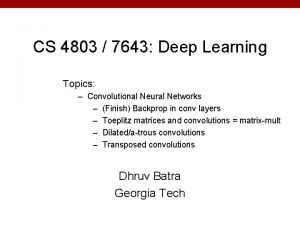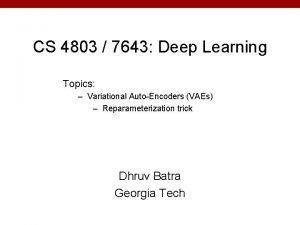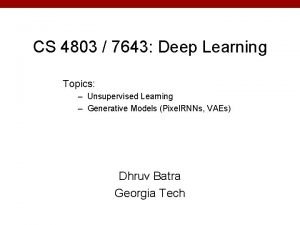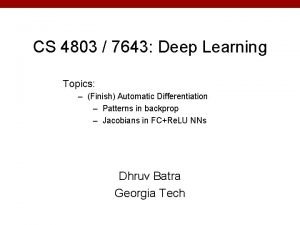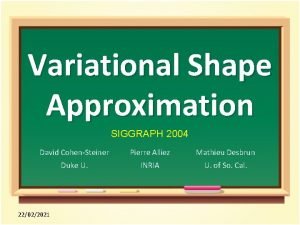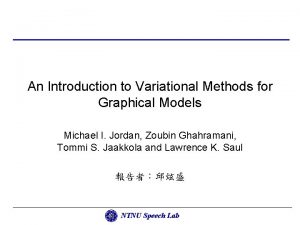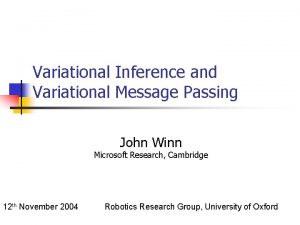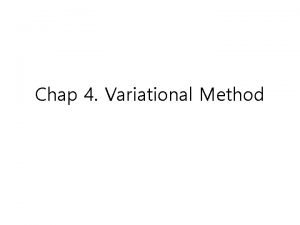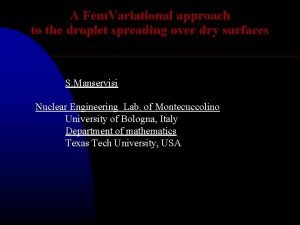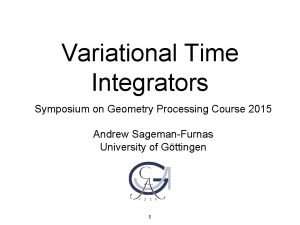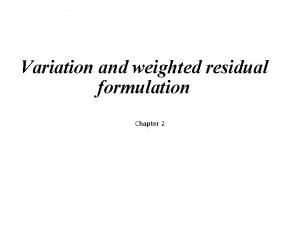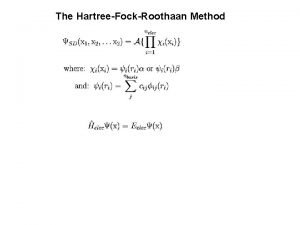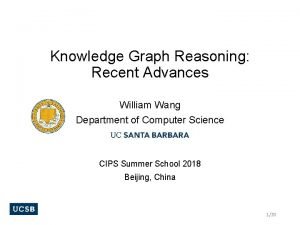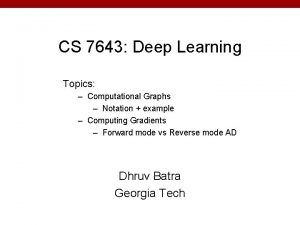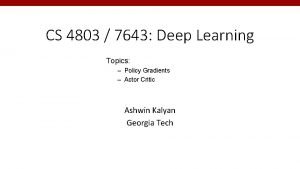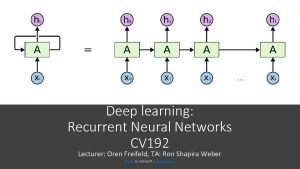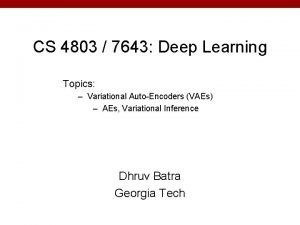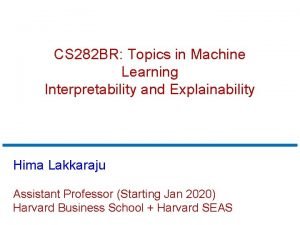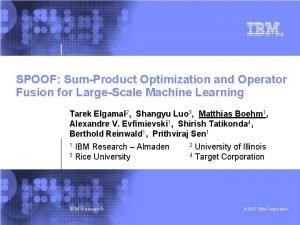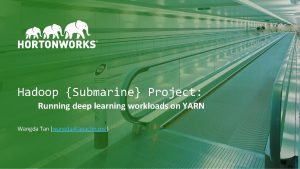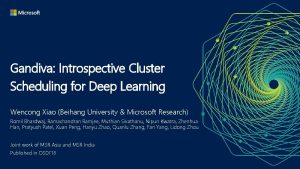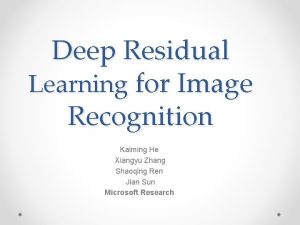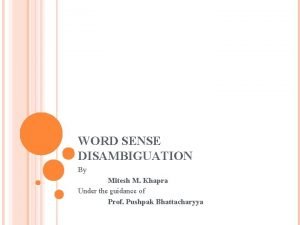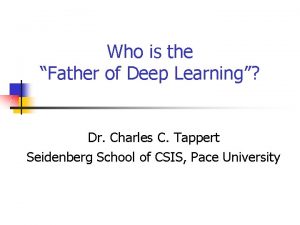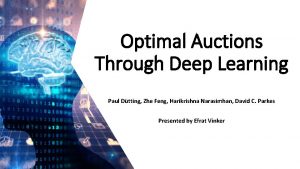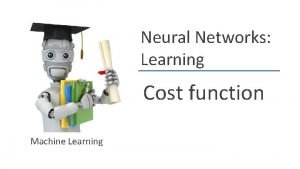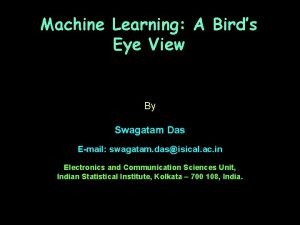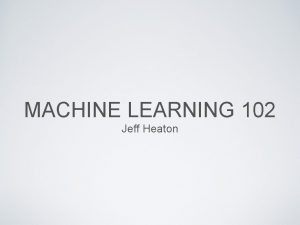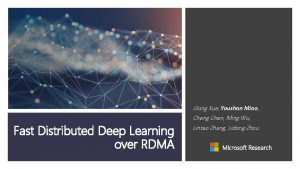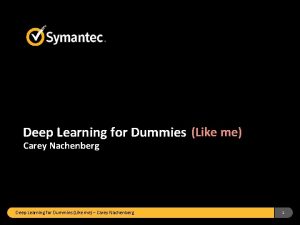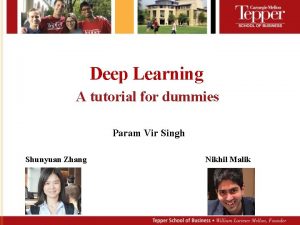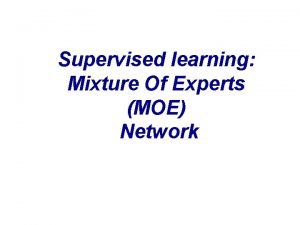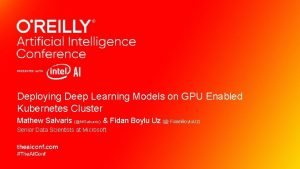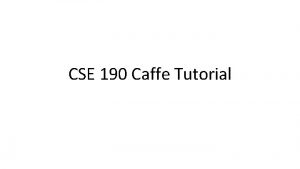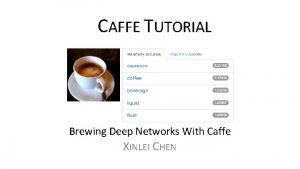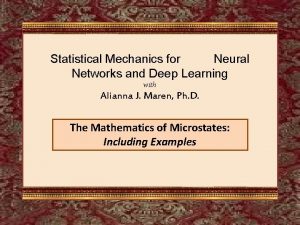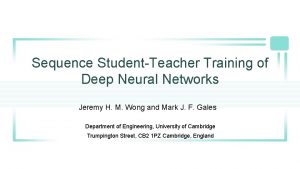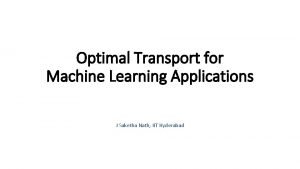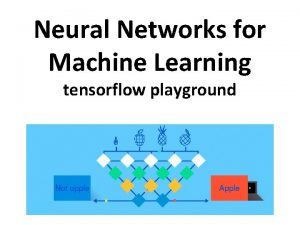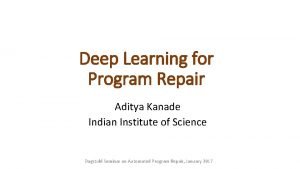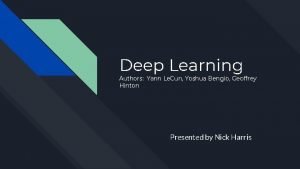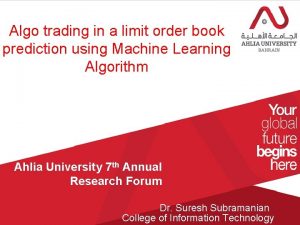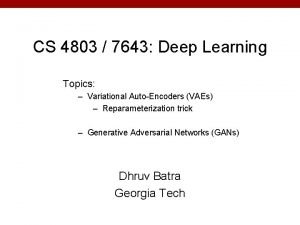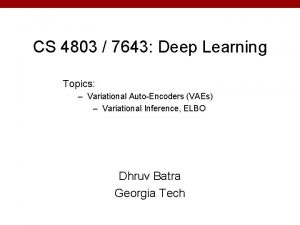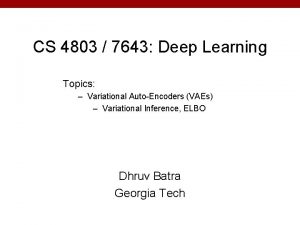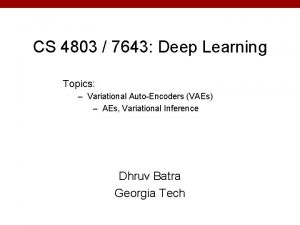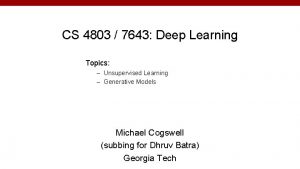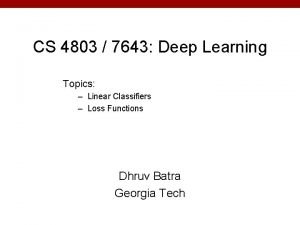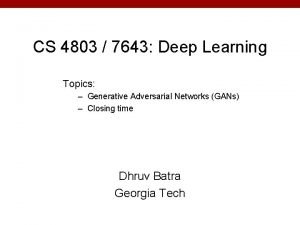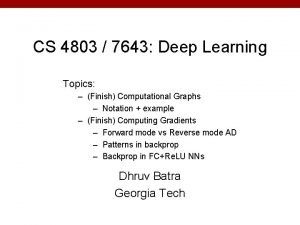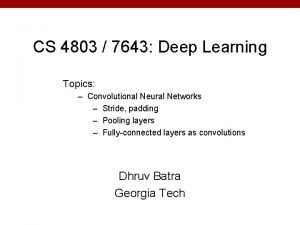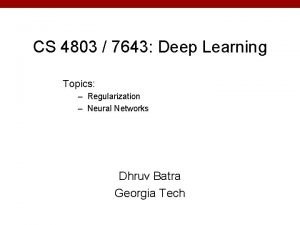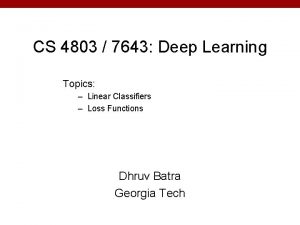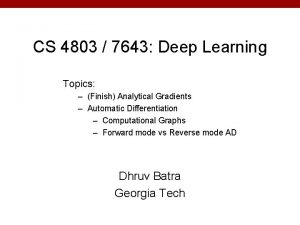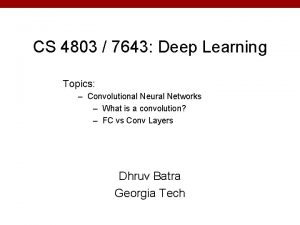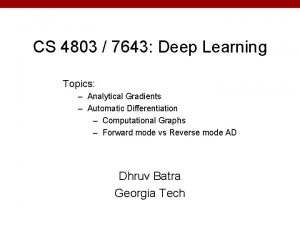CS 4803 7643 Deep Learning Topics Variational AutoEncoders






























































- Slides: 62

CS 4803 / 7643: Deep Learning Topics: – Variational Auto-Encoders (VAEs) – AEs, Variational Inference Dhruv Batra Georgia Tech

Administrativia • HW 4 Reminder – Due: 11/07, 11: 55 pm – Reinforcement Learning – Last HW. Focus on project after that. • Final project – No poster session – PDF Report submission • Details out soon (C) Dhruv Batra 2

Administrativia • HW 3 Grades Released – Regrade requests close: 11/15, 11: 55 pm – Please check solutions first! • Grade histogram: 7643 – Max possible: 71 (regular credit) + 0 (extra credit) (C) Dhruv Batra 3

Administrativia • HW 3 Grades Released – Regrade requests close: 11/15, 11: 55 pm – Please check solutions first! • Grade histogram: 4803 – Max possible: 55 (regular) + 14 (extra credit) (C) Dhruv Batra 4

Recap from last time 2 lectures ago (C) Dhruv Batra 5

Supervised vs Reinforcement vs Unsupervised Learning Slide Credit: Fei-Fei Li, Justin Johnson, Serena Yeung, CS 231 n

Supervised vs Reinforcement vs Unsupervised Learning Supervised Learning Data: (x, y) x is data, y is label Cat Goal: Learn a function to map x y Examples: Classification, regression, object detection, semantic segmentation, image captioning, etc. Classification This image is CC 0 public domain Slide Credit: Fei-Fei Li, Justin Johnson, Serena Yeung, CS 231 n

Supervised vs Reinforcement vs Unsupervised Learning Reinforcement Learning Given: (e, r) Environment e, Reward function r (evaluative feedback) Goal: Maximize expected reward Examples: Robotic control, video games, board games, etc. Slide Credit: Fei-Fei Li, Justin Johnson, Serena Yeung, CS 231 n

Supervised vs Reinforcement vs Unsupervised Learning Data: x Just data, no labels! Goal: Learn some underlying hidden structure of the data Examples: Clustering, dimensionality reduction, feature learning, density estimation, etc. Slide Credit: Fei-Fei Li, Justin Johnson, Serena Yeung, CS 231 n

Supervised vs Reinforcement vs Unsupervised Learning Supervised Learning Data: x Just data, no labels! Data: (x, y) x is data, y is label Goal: Learn some underlying hidden structure of the data Goal: Learn a function to map x y Examples: Clustering, dimensionality reduction, feature learning, density estimation, etc. Examples: Classification, regression, object detection, semantic segmentation, image captioning, etc. Slide Credit: Fei-Fei Li, Justin Johnson, Serena Yeung, CS 231 n

Supervised vs Reinforcement vs Unsupervised Learning Training data is cheap Data: x Just data, no labels! Supervised Learning Data: (x, y) Holy grail: Solve unsupervised learning x is data, y is label => understand structure of visual world Goal: Learn some underlying hidden structure of the data Goal: Learn a function to map x y Examples: Clustering, dimensionality reduction, feature learning, density estimation, etc. Examples: Classification, regression, object detection, semantic segmentation, image captioning, etc. Slide Credit: Fei-Fei Li, Justin Johnson, Serena Yeung, CS 231 n

Tasks Supervised Learning x Classification y Discrete x Regression y Continuous x Clustering c Discrete x Dimensionality Reduction z Continuous x Density Estimation p(x) On simplex Unsupervised Learning (C) Dhruv Batra 13

Supervised vs Reinforcement vs Unsupervised Learning Data: x Just data, no labels! Goal: Learn some underlying hidden structure of the data Examples: Clustering, dimensionality reduction, feature learning, density estimation, etc. K-means clustering Slide Credit: Fei-Fei Li, Justin Johnson, Serena Yeung, CS 231 n This image is CC 0 public domain

K-means 1. Ask user how many clusters they’d like. (e. g. k=5) 2. Randomly guess k cluster Center locations 3. Each datapoint finds out which Center it’s closest to. 4. Each Center finds the centroid of the points it owns… 5. …and jumps there 6. …Repeat until terminated! (C) Dhruv Batra Slide Credit: Carlos Guestrin 15

K-means as Co-ordinate Descent • Optimize objective function: • Fix , optimize a • Fix a, optimize (C) Dhruv Batra Slide Credit: Carlos Guestrin 16

Supervised vs Reinforcement vs Unsupervised Learning Data: x Just data, no labels! Goal: Learn some underlying hidden structure of the data 3 -d Examples: Clustering, dimensionality reduction, feature learning, density estimation, etc. 2 -d Principal Component Analysis (Dimensionality reduction) Slide Credit: Fei-Fei Li, Justin Johnson, Serena Yeung, CS 231 n This image from Matthias Scholz is CC 0 public domain

Supervised vs Reinforcement vs Unsupervised Learning Data: x Just data, no labels! Figure copyright Ian Goodfellow, 2016. Reproduced with permission. 1 -d density estimation Goal: Learn some underlying hidden structure of the data Examples: Clustering, dimensionality reduction, feature learning, density estimation, etc. 2 -d density estimation Slide Credit: Fei-Fei Li, Justin Johnson, Serena Yeung, CS 231 n 2 -d density images left and right are CC 0 public domain

Generative Models Given training data, generate new samples from same distribution Training data ~ pdata(x) Generated samples ~ pmodel(x) Want to learn pmodel(x) similar to pdata(x) Slide Credit: Fei-Fei Li, Justin Johnson, Serena Yeung, CS 231 n

Generative Models Given training data, generate new samples from same distribution Training data ~ pdata(x) Generated samples ~ pmodel(x) Want to learn pmodel(x) similar to pdata(x) Addresses density estimation, a core problem in unsupervised learning Several flavors: - - Explicit density estimation: explicitly define and solve for pmodel(x) Implicit density estimation: learn model that can sample from pmodel(x) w/o explicitly defining it Slide Credit: Fei-Fei Li, Justin Johnson, Serena Yeung, CS 231 n

Why Generative Models? - Realistic samples for artwork, super-resolution, colorization, etc. - Generative models of time-series data can be used for simulation and planning (reinforcement learning applications!) Training generative models can also enable inference of latent representations that can be useful as general features - FIgures from L-R are copyright: (1) Alec Radford et al. 2016; (2) David Berthelot et al. 2017; Phillip Isola et al. 2017. Reproduced with authors permission. Slide Credit: Fei-Fei Li, Justin Johnson, Serena Yeung, CS 231 n

Taxonomy of Generative Models Direct GAN Generative models Explicit density Tractable density Implicit density Markov Chain Approximate density Fully Visible Belief Nets - NADE Variational - MADE - Pixel. RNN/CNN Variational Autoencoder Change of variables models (nonlinear ICA) GSN Markov Chain Boltzmann Machine Figure copyright and adapted from Ian Goodfellow, Tutorial on Generative Adversarial Networks, 2017. Slide Credit: Fei-Fei Li, Justin Johnson, Serena Yeung, CS 231 n

Taxonomy of Generative Models Direct We will discuss 3 most popular types of generative models GAN Generative models Explicit density Tractable density Implicit density Markov Chain Approximate density Fully Visible Belief Nets - NADE Variational - MADE - Pixel. RNN/CNN Variational Autoencoder Change of variables models (nonlinear ICA) GSN Markov Chain Boltzmann Machine Figure copyright and adapted from Ian Goodfellow, Tutorial on Generative Adversarial Networks, 2017. Slide Credit: Fei-Fei Li, Justin Johnson, Serena Yeung, CS 231 n

Fully Observable Model Explicit density model Use chain rule to decompose likelihood of an image x into product of 1 -d distributions: Likelihood of image x Probability of i’th pixel value given all previous pixels Then maximize likelihood of training data Slide Credit: Fei-Fei Li, Justin Johnson, Serena Yeung, CS 231 n

Fully Observable Model Explicit density model Use chain rule to decompose likelihood of an image x into product of 1 -d distributions: Likelihood of image x Probability of i’th pixel value given all previous pixels Then maximize likelihood of training data Complex distribution over pixel values => Express using a neural network! Slide Credit: Fei-Fei Li, Justin Johnson, Serena Yeung, CS 231 n

Plan for Today • Goal: Variational Autoencoders • Latent variable probabilistic models – Example GMMs • Autoencodeders • Variational Inference (C) Dhruv Batra 26

Variational Autoencoders (VAE)

So far. . . Pixel. CNNs define tractable density function, optimize likelihood of training data: Slide Credit: Fei-Fei Li, Justin Johnson, Serena Yeung, CS 231 n

So far. . . Pixel. CNNs define tractable density function, optimize likelihood of training data: VAEs define intractable density function with latent z: Slide Credit: Fei-Fei Li, Justin Johnson, Serena Yeung, CS 231 n

So far. . . Pixel. CNNs define tractable density function, optimize likelihood of training data: VAEs define intractable density function with latent z: Cannot optimize directly, derive and optimize lower bound on likelihood instead Slide Credit: Fei-Fei Li, Justin Johnson, Serena Yeung, CS 231 n

GMM (C) Dhruv Batra Figure Credit: Kevin Murphy 31

Gaussian Mixture Model (C) Dhruv Batra 32

Gaussian Mixture Model (C) Dhruv Batra 33

GMM (C) Dhruv Batra Figure Credit: Kevin Murphy 35

K-means vs GMM • K-Means – http: //stanford. edu/class/ee 103/visualizations/kmean s. html • GMM – https: //lukapopijac. github. io/gaussian-mixture-model/ (C) Dhruv Batra 36

Hidden Data Causes Problems #1 • Fully Observed (Log) Likelihood factorizes • Marginal (Log) Likelihood doesn’t factorize • All parameters coupled! (C) Dhruv Batra 37

(C) Dhruv Batra 38

Hidden Data Causes Problems #2 • Identifiability (C) Dhruv Batra Figure Credit: Kevin Murphy 39

Hidden Data Causes Problems #3 • Likelihood has singularities if one Gaussian “collapses” (C) Dhruv Batra 40

(C) Dhruv Batra 41

Variational Auto Encoders VAEs are a combination of the following ideas: 1. Auto Encoders 2. Variational Approximation • Variational Lower Bound / ELBO 3. Amortized Inference Neural Networks 4. “Reparameterization” Trick (C) Dhruv Batra 42

Autoencoders Unsupervised approach for learning a lower-dimensional feature representation from unlabeled training data Features Encoder Input data Slide Credit: Fei-Fei Li, Justin Johnson, Serena Yeung, CS 231 n

Autoencoders Unsupervised approach for learning a lower-dimensional feature representation from unlabeled training data Originally: Linear + nonlinearity (sigmoid) Later: Deep, fully-connected Later: Re. LU CNN Features Encoder Input data Slide Credit: Fei-Fei Li, Justin Johnson, Serena Yeung, CS 231 n

Autoencoders Unsupervised approach for learning a lower-dimensional feature representation from unlabeled training data z usually smaller than x (dimensionality reduction) Q: Why dimensionality reduction? Originally: Linear + nonlinearity (sigmoid) Later: Deep, fully-connected Later: Re. LU CNN Features Encoder Input data Slide Credit: Fei-Fei Li, Justin Johnson, Serena Yeung, CS 231 n

Autoencoders Unsupervised approach for learning a lower-dimensional feature representation from unlabeled training data z usually smaller than x (dimensionality reduction) Q: Why dimensionality reduction? A: Want features to capture meaningful factors of variation in data Originally: Linear + nonlinearity (sigmoid) Later: Deep, fully-connected Later: Re. LU CNN Features Encoder Input data Slide Credit: Fei-Fei Li, Justin Johnson, Serena Yeung, CS 231 n

Autoencoders How to learn this feature representation? Features Encoder Input data Slide Credit: Fei-Fei Li, Justin Johnson, Serena Yeung, CS 231 n

Autoencoders How to learn this feature representation? Train such that features can be used to reconstruct original data “Autoencoding” - encoding itself Reconstructed input data Decoder Features Encoder Input data Slide Credit: Fei-Fei Li, Justin Johnson, Serena Yeung, CS 231 n

Autoencoders Reconstructed data How to learn this feature representation? Train such that features can be used to reconstruct original data “Autoencoding” - encoding itself Reconstructed input data Encoder: 4 -layer conv Decoder: 4 -layer upconv Decoder Features Encoder Input data Slide Credit: Fei-Fei Li, Justin Johnson, Serena Yeung, CS 231 n Input data

Autoencoders Reconstructed data Train such that features can be used to reconstruct original data L 2 Loss function: Reconstructed input data Encoder: 4 -layer conv Decoder: 4 -layer upconv Decoder Features Encoder Input data Slide Credit: Fei-Fei Li, Justin Johnson, Serena Yeung, CS 231 n Input data

Autoencoders Reconstructed data Train such that features can be used to reconstruct original data L 2 Loss function: Doesn’t use labels! Reconstructed input data Encoder: 4 -layer conv Decoder: 4 -layer upconv Decoder Features Encoder Input data Slide Credit: Fei-Fei Li, Justin Johnson, Serena Yeung, CS 231 n Input data

Autoencoders • Demo – https: //cs. stanford. edu/people/karpathy/convnetjs/demo/auto encoder. html 53

Autoencoders Reconstructed input data Decoder After training, throw away decoder Features Encoder Input data Slide Credit: Fei-Fei Li, Justin Johnson, Serena Yeung, CS 231 n

Autoencoders Loss function (Softmax, etc) bird dog plane deer truck Predicted Label Encoder can be used to initialize a supervised model Classifier Features Fine-tune encoder jointly with classifier Encoder Input data Slide Credit: Fei-Fei Li, Justin Johnson, Serena Yeung, CS 231 n Train for final task (sometimes with small data)

Autoencoders can reconstruct data, and can learn features to initialize a supervised model Reconstructed input data Decoder Features capture factors of variation in training data. Can we generate new images from an autoencoder? Encoder Input data Slide Credit: Fei-Fei Li, Justin Johnson, Serena Yeung, CS 231 n

Variational Autoencoders Probabilistic spin on autoencoders - will let us sample from the model to generate data! Image Credit: https: //jaan. io/what-is-variational-autoencoder-vae-tutorial/

Variational Auto Encoders VAEs are a combination of the following ideas: 1. Auto Encoders 2. Variational Approximation • Variational Lower Bound / ELBO 3. Amortized Inference Neural Networks 4. “Reparameterization” Trick (C) Dhruv Batra 58

Key problem • P(z|x) (C) Dhruv Batra 59

What is Variational Inference? • A class of methods for – approximate inference, parameter learning – and approximating integrals basically. . • Key idea – Reality is complex – Instead of performing approximate computation in something complex, – Can we perform exact computation in something “simple”? – Just need to make sure the simple thing is “close” to the complex thing. (C) Dhruv Batra 60

Intuition (C) Dhruv Batra 61

KL divergence: Distance between distributions • Given two distributions p and q KL divergence: • D(p||q) = 0 iff p=q • Not symmetric – p determines where difference is important (C) Dhruv Batra Slide Credit: Carlos Guestrin 62

Find simple approximate distribution • Suppose p is intractable posterior • Want to find simple q that approximates p • KL divergence not symmetric • D(p||q) – true distribution p defines support of diff. – the “correct” direction – will be intractable to compute • D(q||p) – approximate distribution defines support – tends to give overconfident results – will be tractable (C) Dhruv Batra Slide Credit: Carlos Guestrin 63

Example 1 • p = 2 D Gaussian with arbitrary co-variance • q = 2 D Gaussian with diagonal co-variance argmin_q KL (p || q) (C) Dhruv Batra argmin_q KL (q || p) p = Green; q = Red 64

Example 2 • p = Mixture of Two Gaussians • q = Single Gaussian argmin_q KL (p || q) (C) Dhruv Batra argmin_q KL (q || p) p = Blue; q = Red 65
 Autoencoders
Autoencoders Cs 4803
Cs 4803 Pooling stride
Pooling stride Cs 7643 deep learning
Cs 7643 deep learning Fei fei li
Fei fei li Autoencoders
Autoencoders Cs 224
Cs 224 Cs 4803 gatech
Cs 4803 gatech Cs 4803
Cs 4803 Cs 4803
Cs 4803 Cs 4803
Cs 4803 Cs 7643
Cs 7643 Variational shape approximation
Variational shape approximation An introduction to variational methods for graphical models
An introduction to variational methods for graphical models Variational message passing
Variational message passing Variational principle
Variational principle Reboundd
Reboundd Variational calculus
Variational calculus Example of residual formulation
Example of residual formulation The hamiltonian operator is given by
The hamiltonian operator is given by Variational knowledge graph reasoning
Variational knowledge graph reasoning Cs 7643
Cs 7643 Cs 7643 github
Cs 7643 github Lstm colah
Lstm colah Cs 7643
Cs 7643 Cmu machine learning
Cmu machine learning Tony wagner's seven survival skills
Tony wagner's seven survival skills Deep asleep deep asleep it lies
Deep asleep deep asleep it lies Deep forest: towards an alternative to deep neural networks
Deep forest: towards an alternative to deep neural networks O the deep deep love of jesus
O the deep deep love of jesus Cuadro comparativo e-learning m-learning b-learning
Cuadro comparativo e-learning m-learning b-learning Cs 282
Cs 282 Global citizenship education topics and learning objectives
Global citizenship education topics and learning objectives Operator fusion deep learning
Operator fusion deep learning Rnn
Rnn Hadoop deep learning
Hadoop deep learning Gandiva: introspective cluster scheduling for deep learning
Gandiva: introspective cluster scheduling for deep learning Kaiming he
Kaiming he Deep learning speech recognition
Deep learning speech recognition Vas3k machine learning
Vas3k machine learning Sachin tendulkar
Sachin tendulkar Who is the father of deep learning?
Who is the father of deep learning? Dtting
Dtting New pedagogies for deep learning
New pedagogies for deep learning Cost function in deep learning
Cost function in deep learning Bird eye view deep learning
Bird eye view deep learning Jeff heaton github
Jeff heaton github Jilong xue
Jilong xue Carey nachenberg slides
Carey nachenberg slides Convolution for dummies
Convolution for dummies Moe deep learning
Moe deep learning Xkcd artificial intelligence
Xkcd artificial intelligence Intel deep learning training tool
Intel deep learning training tool Kubernetes vgpu
Kubernetes vgpu Caffe tutorial
Caffe tutorial Caffe tutorial
Caffe tutorial Statistical mechanics of deep learning
Statistical mechanics of deep learning Student teacher neural network
Student teacher neural network Ioslides
Ioslides Google machine learning playground
Google machine learning playground Deepfix: fixing common c language errors by deep learning
Deepfix: fixing common c language errors by deep learning Le cun
Le cun Deep learning for limit order books
Deep learning for limit order books

